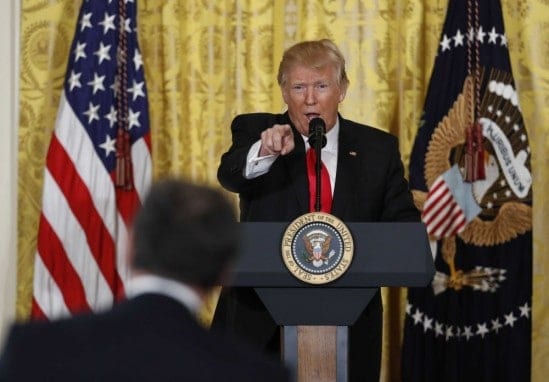President Trump has a famously testy relationship with the media, which he frequently accuses of being “fake news.” Both sides blame the other. It’s a grim situation, but is it any different from previous administrations?
John Woolley and Joshua Meyer-Gutbrod decided to find out. Woolley, a UC Santa Barbara professor of political science, and Meyer-Gutbrod, a National Science Foundation Postdoctoral Research Fellow at UCSB, turned to The American Presidency Project (APP), of which Woolley is co-director.
The APP has an archive of press briefing transcripts going back to the Clinton administration, and Meyer-Gutbrod suggested analyzing them for tone, he said, to “search for any trends over time.” To his surprise, the answer was clear: the Trump administration marks a distinct shift with its tone and relationship with the press.
In “New conflicts in the briefing room: using sentiment analysis to evaluate administration-press relations from Clinton through Trump” in the journal Political Communication, Meyer-Gutbrod and Woolley report that in previous administrations, the press and White House officials generally mirrored one another’s positive and negative language during briefings.
However, Meyer-Gutbrod said, “the Trump Administration is more negative than previous administrations, while we observe no similar shift on the part of the media. We also found the Trump Administration to be more sensitive to negativity by the members of the media in the briefing room.”
“Any increase in negativity on the part of the press, any additional sort of pressure on questions or discussion of negative topics, results in a decline in positivity on the administration,” he added, “It seems like they sort of shut down and stop engaging.”
Woolley, who co-founded the APP in 1999, said that because the paper is potentially controversial, he and Meyer-Gutbrod took pains to be as objective as possible.
“It was important that the research not be set up so as to deliver a predetermined outcome,” Woolley said. “It’s totally straight; not pre-cooked.”
The scholars’ analysis focuses on “press briefings,” the regular interaction between administration officials and members of the White House press corps. Typically, those briefings begin with a short statement by the press secretary or other official, followed by a period of questioning by reporters. Their relative frequency and informality lend a better measure of tone and texture of the White House, the paper notes.
The APP has collected transcripts of all briefings that have been posted on the White House website, starting with the Clinton administration in 1993. It includes all briefings conducted by all members of the president’s administration, including briefings (usually done in the White House Press Room), gaggles (informal briefings outside the press room) and press calls (through telephone conferences).
Meyer-Gutbrod, the lead author, and Woolley analyzed the transcripts of press briefings from 1993 through 2018, using only the first congressional session of each presidential term to provide for a direct comparison with the data available for the Trump Administration.
The scholars then conducted a sentiment analysis, first separating statements by the administration and questions or comments by the press. They then measured positive and negative sentiment for each group.
With that data they generated three pairs of models based on the weekly tone of the administration and the press. The results, Meyer-Gutbrod said, were striking. Press relations with the Clinton, Bush and Obama years were rather consistent. The Trump administration, however, became remarkably, and abruptly, negative.
“What we found was that the Trump administration was more negative than the previous three administrations, with no comparative change in the tone of the media,” Meyer-Gutbrod said. “Now, if we saw a change in the tone on both sides, if the media became more negative alongside the Trump administration, we wouldn’t be able to determine if the shift was merely a product of the content of conversation.”
“Topics like terrorism and crime could lead to a shift in tone from both groups,” he continued. “But that one-sided tone shift was a really strong indication that there’s something going on within the administration.”
Because the analysis didn’t focus on specifically Trump, who frequently expresses his contempt for the press, Meyer-Gutbrod said he didn’t expect to see much change within the administration more broadly. That was not the case.
“The reality is it’s not just Trump,” he said. “There seems to be a systemic attitude here within the administration about the goal, specifically, the way to control the message. It’s not just Trump’s response to the media, but the entire administration which is either simply mirroring Trump or potentially recognizing the value in his approach.”
Woolley said the research is a great example of the scholarly work made possible because of the APP’s digitized document archive. The researchers are looking at how the press briefing collection — and just about every other aspect of the archive — could be expanded and deepened, to facilitate similarly informative research.
He also noted that research was done long before pandemic took hold, with their associated lengthy daily White House briefings.
“But our question, about the origins of the administration’s bad relations with the news, is of great importance in this moment,” Woolley said. “The administration realizes that broad public communication is essential for coping with this crisis. But they are having a hard time overcoming the harsh relationship that exists with most major media outlets. Our research, reaching back to the first Clinton years, shows that this harsh relationship was initiated by the administration, not by the media.”


